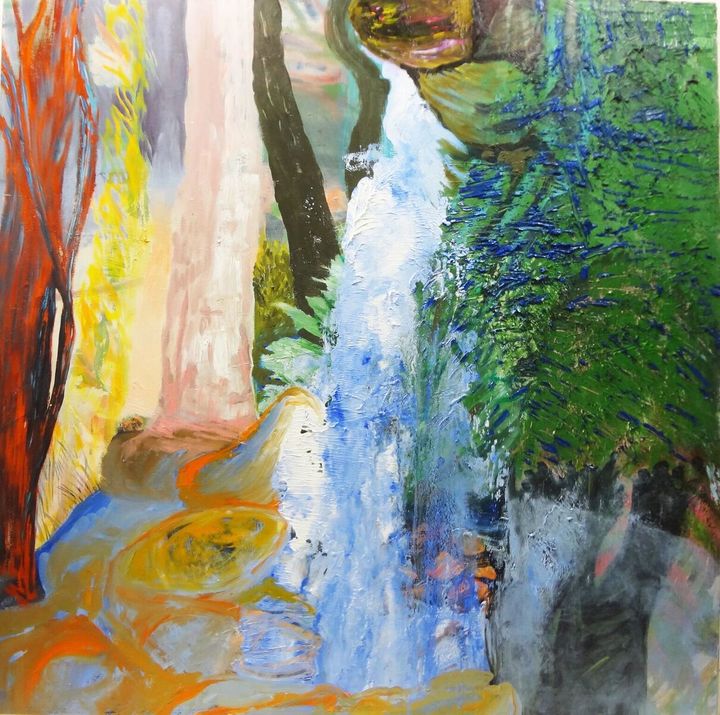Cecilia Whittaker-Doe had a grandmother who lived with her family in Putnam Valley, New York. This grandmother and her sister had spent several years in an orphanage before they moved into a tenement building in Manhattan. In time, this grandmother of Whittaker-Doe’s would marry and move up to Putnam Valley and that was how Whittaker-Doe and her family came to develop roots in that area.
Whittaker-Doe’s grandmother would tell her stories about jumping from rooftop to rooftop in New York City even as she lamented that the trees where she now lived were being cut down. “In my paintings, I feel that I am melding the two worlds that my grandmother talked about, because what I am doing is creating a familiar world that is somehow unfamiliar. I always felt that my grandmother was connected to both the woods and the city life – worlds that were both familiar and unfamiliar.”

Born in Peekskill, New York, Cecilia Whittaker-Doe grew up on a farm where she wandered the woods, streams and lakes. Hers was a landscape populated by deer, horses, goats, chickens, and where her closet friends were a ten-mile car ride away. She belonged to a large Catholic family of seven siblings. Her father was a local disc jockey, while her mother worked on budgets for the county.
Most of Whittaker-Doe’s early education was in Catholic institutions where she felt her artistic aspirations were always nurtured. “In school I was good at two things, really,” the artist shared with me. “I was good at art and I had a talent for sports. By the time I graduated from high school I had a very solid art education and it was very obvious I was going to become some kind of artist.”

Even then, her focus on the landscape and the natural environment was becoming evident. In time, the landscape, for Cecilia Whittaker-Doe, would become a metaphor for moving through life. She particularly remembers the painting class she took in her senior year of high school at Lakeland High School. Because Lakeland High was located in the affluent Westchester County, this class was taught in a separate private annex, which, for the artist, represented a private enclosed world. It was in that annex that she painted a small vertical work of a Canadian goose which still survives.
The artist would go on to attend The State University of New York College at Buffalo, which counts Cindy Sherman and Robert Longo as alums, and where she would learn the persistence that is needed in making art. “I had a painting teacher, Richard Gubernick, who had us make a painting per week – which was nuts! But it forced us to make decisions and it forced us to jump right into the medium.”
At the same time that she was exploring painting, she was becoming increasingly interested in textile design, and would have enough credits to almost have a double major in painting and textile design. “For textiles, I studied with a woman named Lori Christmastree. With her I started experimenting with flat pattern, texture, and color, though I was doing this differently than I had done with painting. In time, I would feel as though between Gubernick and Christmastree, I had two strong mentors.”

At SUNY, Buffalo State, Whittaker-Doe developed a fondness for the landscape watercolors of Charles Birchfield, which she believed showed Birchfield’s dark side, and she would often visit the Charles Birchfield Center at the College. When it came time for her to do her thesis work and have her graduation show, she came up with an alphabet, that was influenced by Birchfield’s alphabet, with which she paired large paintings that had marks that came together to make landscapes.
By then, her interest in the landscape had become more pronounced and she found that she was using paint to try to get the viewer involved in individual paintings. The artist believes that a painting is always asking its viewer to make decisions. In one of her works during this time, she painted her model twice into the work, and did not think much about this duplication until her painting instructor found what she was doing fascinating and questioned her about it. The instructor would eventually hand her a book on Matisse. Her work, the instructor told Cecilia Whittaker-Doe, was reminiscent of Matisse in his use of repetition in the forms in his paintings.

“What I learnt then was that a painting has to have rhythm and you can use repetition in a work to create a rhythm. Reading about Matisse did free me up to use repetition in my work, but that impulse was already there. I think what remains of this in my current output is working with and through the repetition that one sees in nature. Things can seem so similar and familiar when you are out in the woods, yet, once you move, it is all different. This is why people often get lost in the woods. There is a familiarity, you feel like you have seen this before, even when you are standing in a place where you have never stood before.”
In her paintings, Cecilia Whittaker-Doe is trying to create a familiar place that is at the same time unfamiliar. She is always trying to upend some of the nostalgic romantic notions attached to landscape work by showing that nature is not necessarily and certainly not always a place of warmth and comfort, even though it certainly can be this. For the artist, things grow in nature, but they may not grow in the ways that we expect. Consequently, nature can be unpredictable and in nature, anything can happen. There is an element of risk involved in going into nature and this risk might be good or it might be bad. Indeed, many of the rules that we often adhere to, oftentimes, the artist maintains, go through the window when we are dealing with the natural landscape and with nature.

“In the past, in so far as my paintings were concerned, I used to think, you have to have a place for the viewer to stand in the work and the viewer has to be comfortable where s/he is standing in the work to fully appreciate the work. I no longer believe this. Rather, I now believe that the viewer has to find a place to stand in the work, and decide from there, where to go.”
In her most recent paintings, Whittaker-Doe is playing with and asking questions about transformation and how much one can alter a landscape while still having it remain recognizable. It is an audacious tension in her work. More and more ideas such as 'play' and 'magic' are infusing her painting vocabulary. When she painted the female figure twice into the painting so many years before as an art student, that was an instance of both play and magic and she is trying to get back to that more and more in her work.
What advice, then, would Cecilia Whittaker-Doe give to a younger artist, seeking to find her artistic voice, as she so resolutely has?

“I would say to an artist seeking his/her way that you have to expose yourself to what is going on in your field, particularly so to any area that you are interested in – be sure to go out and look. But also take the time to learn what you own in your work. Come to know what is yours. That is what will set you apart in what you do and that is what will see you through.”
Until next time.
